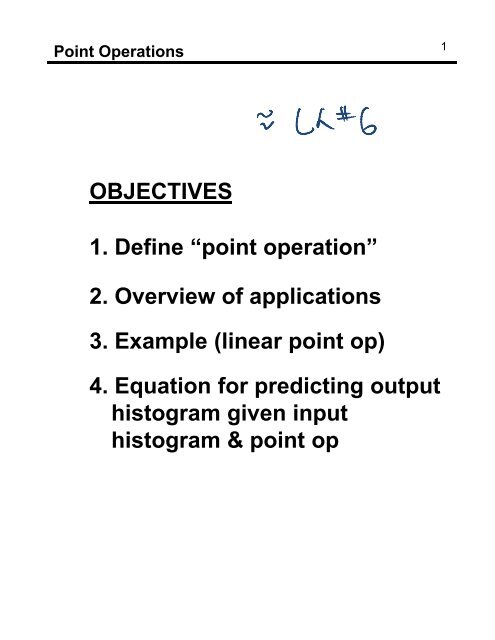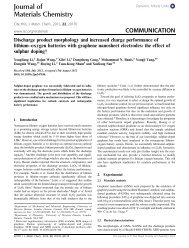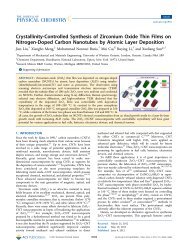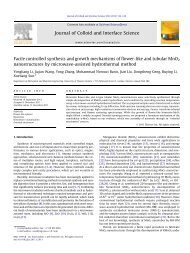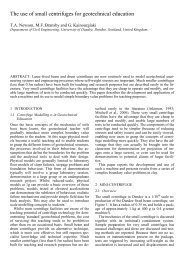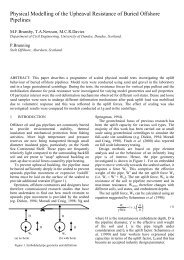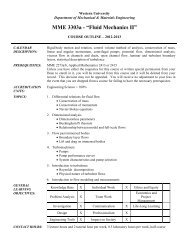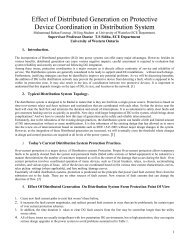OBJECTIVES 1. Define “point operation” 2. Overview of applications ...
OBJECTIVES 1. Define “point operation” 2. Overview of applications ...
OBJECTIVES 1. Define “point operation” 2. Overview of applications ...
Create successful ePaper yourself
Turn your PDF publications into a flip-book with our unique Google optimized e-Paper software.
Point Operations<br />
<strong>OBJECTIVES</strong><br />
<strong>1.</strong> <strong>Define</strong> <strong>“point</strong> <strong>operation”</strong><br />
<strong>2.</strong> <strong>Overview</strong> <strong>of</strong> <strong>applications</strong><br />
3. Example (linear point op)<br />
4. Equation for predicting output<br />
histogram given input<br />
histogram & point op<br />
1
Definition <strong>of</strong> Point Operation<br />
A(x, y) - Input B(x, y) - Output<br />
Point operations modify way in which<br />
image fills available gray-scale range.<br />
Also called contrast enhancement,<br />
contrast stretching and gray-scale<br />
transformations (GST).<br />
2
Mathematical Definition <strong>of</strong> Point Operation<br />
A(x, y) - Input B(x, y) - Output<br />
f<br />
3
<strong>Overview</strong> <strong>of</strong> Applications<br />
• Contrast Enhancement<br />
• Photometric Calibration<br />
• Thresholding (discussed)<br />
• Clipping (discussed)<br />
4
<strong>Overview</strong> <strong>of</strong> Applications<br />
Contrast Enhancement<br />
Features <strong>of</strong> interest may occupy a<br />
narrow range <strong>of</strong> the gray scale.<br />
May wish to expand contrast so<br />
features <strong>of</strong> interest occupy a larger<br />
range <strong>of</strong> displayed gray levels.<br />
Before<br />
After histogram<br />
equalization<br />
We will look at histogram equalization<br />
and histogram matching later.<br />
5
<strong>Overview</strong> <strong>of</strong> Applications<br />
Photometric Calibration<br />
Digitizer may have a nonlinear<br />
response to light intensity, but we<br />
may want gray levels in image to be<br />
proportional to intensity.<br />
Can design point operation to get rid<br />
<strong>of</strong> nonlinearity.<br />
6
<strong>Overview</strong> <strong>of</strong> Applications<br />
• Display Calibration<br />
Relationship between brightness <strong>of</strong><br />
cathode-ray tube (CRT) phosphors to<br />
applied voltage is nonlinear - gamma<br />
response characteristic.<br />
Can design a point operation to<br />
compensate for nonlinearity.<br />
• Clipping<br />
An operation may produce an image<br />
having gray levels outside the<br />
allowed range (0 - D max).<br />
Set negative values to 0 and those<br />
greater than D max to D max.<br />
What is D max for an 8-bit image?.<br />
7
Linear Point Operation<br />
255<br />
b<br />
0<br />
D B<br />
a<br />
( )<br />
f D = aD +<br />
b<br />
A A<br />
255<br />
D A<br />
8
Linear Point Operation<br />
b affects brightness <strong>of</strong> image<br />
by shifting gray levels.<br />
E.g., a = 1 (no gain) and b = -74<br />
Before After<br />
Q: What is effect <strong>of</strong> positive b?<br />
9
Linear Point Operation<br />
a affects contrast as well as<br />
brightness.<br />
E.g., a = <strong>1.</strong>14 = 255/224, b = 0<br />
Before After<br />
Q: What is effect <strong>of</strong> 0 < |a| < 1?<br />
Q: What is effect <strong>of</strong> a < 0?<br />
10
Equation for Output Histogram<br />
GIVEN:<br />
(1) Point operation f(D A) that maps<br />
input image A(x, y) into output B(x, y)<br />
(2) Histogram <strong>of</strong> input, H A(D A)<br />
DERIVE: Expression for histogram <strong>of</strong><br />
output, H B(D B), in terms <strong>of</strong> f(D A) and<br />
H A(D A).<br />
WHY?<br />
So we can design point operation to<br />
achieve desired histogram.<br />
11
D B = f(D A)<br />
D B<br />
Equation for Output Histogram<br />
255<br />
D B + ∆∆∆∆D B<br />
∆∆∆∆D B<br />
D B<br />
D A<br />
0<br />
H A(D A)<br />
H B(D B)<br />
∆∆∆∆D A<br />
12<br />
D A<br />
255<br />
D A + ∆∆∆∆D A<br />
D A<br />
0
Summary<br />
• Point operations transform the gray<br />
scale <strong>of</strong> an image<br />
• Mathematically specified by the grayscale<br />
transformation (GST) f (D) that<br />
expresses the mapping between<br />
input and output gray levels<br />
• Useful for contrast enhancement,<br />
photometric & display calibration,<br />
thresholding, clipping<br />
• Given the histogram <strong>of</strong> the input,<br />
HA(DA), and the GST f (DA), can<br />
predict output histogram using the<br />
equation:<br />
( )<br />
H D<br />
f<br />
B B<br />
where<br />
′ =<br />
df<br />
dD<br />
=<br />
A<br />
( −1(<br />
) )<br />
− 1(<br />
)<br />
H f D<br />
A B<br />
( ) B<br />
f ′ f D<br />
13


